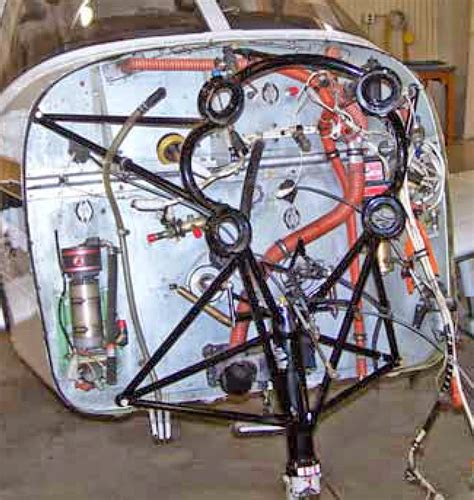Discover the role, materials, types, and maintenance of aircraft engine mounts and their importance for aircraft performance and safety.When it comes to aviation, every component of an aircraft is crucial to its performance and safety, and the engine mount is no exception. This seemingly simple structure plays an essential role in securing the engine to the airframe, ensuring stability during flight and minimizing vibrations. In this blog post, we will explore the various facets of aircraft engine mounts, starting with a clear definition of what they are. We’ll delve into the materials used in their construction, highlighting their importance to overall aircraft integrity. By examining the different types of engine mounts and the vital maintenance practices needed to keep them in optimal condition, we aim to provide a comprehensive understanding of this critical component of aviation engineering. Join us as we take flight into the fascinating world of aircraft engine mounts.
What is an Aircraft Engine Mount?
An aircraft engine mount serves as a critical component in the structure of an aircraft, designed to securely attach the engine to the airframe while also accommodating the engine’s weight and vibrations, which ensures not only the integrity of the aircraft’s performance but also the safety of its operation.
Typically fabricated from materials engineered for strength and resilience, the engine mount plays a pivotal role in maintaining the alignment of the engine with the aircraft’s fuselage, which is essential for optimal aerodynamics and fuel efficiency during flight.
Moreover, the design of the engine mount can vary significantly based on factors such as the type of aircraft and the specific engine used, but irrespective of their variations, they universally encapsulate the mechanical and acoustic properties required to minimize engine vibrations transferring to the airframe, enhancing passenger comfort and structural longevity.
To summarize the various functions and roles of an aircraft engine mount, consider the following key points:
- Structural Support: It provides a robust framework to hold the engine securely.
- Vibration Damping: It reduces the transmission of vibrations from the engine to the airframe.
- Alignment Maintenance: It keeps the engine correctly aligned with other critical flight systems.
A well-designed engine mount is essential for ensuring both flight safety and aircraft performance.
This integral part of an aircraft should never be overlooked, as it embodies not only engineering innovation but also the commitment to safety in aviation.
Materials Used in Engine Mounts
When it comes to the construction of aircraft engine mounts, the choice of materials plays a crucial role not only in ensuring the structural integrity of the mount itself but also in enhancing the overall performance and durability of aircraft operations, which includes absorbing vibrations, managing dynamic loads, and withstanding extreme environmental conditions.
The most commonly utilized materials in engine mounts include aluminum alloys, which are favored for their lightweight properties coupled with excellent strength-to-weight ratios, thus allowing for improved fuel efficiency and performance. In addition to aluminum, composite materials such as carbon-fiber reinforced polymers are increasingly being employed in modern aircraft designs due to their high strength and corrosion resistance, ultimately providing a significant reduction in weight while enhancing the lifespan of the engine mount.
Furthermore, other materials like rubber and steel are often integrated into the design of engine mounts as they serve different functional purposes; for instance, rubber components are essential for vibration isolation, which in turn helps protect sensitive flight systems from destructive vibrations, while steel components might be used in specific applications where increase
Importance of Engine Mounts in Aircraft
In the intricate world of aviation, the importance of engine mounts cannot be overstated, as these critical components serve as the connection between the aircraft’s engine and its airframe, ensuring that the engine operates efficiently and that vibrations are minimized, which in turn protects both structural integrity and passenger comfort.
Moreover, the engine mount provides essential alignment for the engine, facilitating optimal performance while also accommodating thermal expansion and contraction due to varying operating conditions, which highlights the necessity of these mounts in ensuring that an aircraft can withstand both the rigors of flight and the complexities of differential movement between components.
Additionally, during both routine inspections and regular maintenance schedules, the engineers give special attention to the condition and effectiveness of the engine mounts; any signs of wear, fatigue, or damage can lead to severe implications not only for the aircraft’s performance but also for overall safety, thus reiterating the critical role that engine mounts play in the aviation industry.
Types of Engine Mounts
When discussing the types of engine mounts, it is essential to recognize that these critical components serve various purposes depending on the specific design and requirements of the aircraft, leading to a categorization that can primarily be segmented into two main types: rigid engine mounts and flexible engine mounts. Rigid engine mounts are designed to maintain a fixed relationship between the engine and the airframe while resisting all types of motion, providing a more stable mounting solution, which is particularly suitable for high-performance aircraft that demand precision and stability in flight.
On the other hand, flexible engine mounts offer a significant degree of freedom of movement, which allows for the absorption of vibrations and the mitigation of noise, characteristics that are particularly important in commercial aviation where passenger comfort is a priority; these flexible mounts are often constructed using materials such as rubber or other elastomeric compounds that provide both damping and isolation, thus enhancing the overall performance and longevity of the engine system.
In addition to the primary categories of rigid and flexible engine mounts, aircraft manufacturers may also implement hybrid mounting solutions that combine elements of both types, incorporating advanced materials and designs to optimize performance for specific aircraft types while meeting stringent safety and regulatory standards; as technology progresses, the innovation in materials such as lightweight composites and advanced alloys continues to redefine the landscape of aircraft engine mounts, providing even greater options for engineers and manufacturers alike.
Maintenance and Inspection of Engine Mounts
The maintenance and inspection of aircraft engine mounts are crucial components of ensuring the safety and reliability of an aircraft, as these mounts serve to support the weight of the engines while also dampening vibrations and loads transmitted from the engine to the airframe; thus, establishing the structural integrity of the entire aircraft system.
Regular inspections, which should occur at defined intervals, are essential for identifying potential wear and tear, or any structural deficiencies that could compromise the engine mount’s performance, often necessitating a detailed examination of the critical attachment points, bolts, and surrounding structures to uncover signs of fatigue or corrosion that could lead to failures; it is also important to follow the manufacturer’s maintenance guidelines and industry standards to ensure that all relevant parameters are met.
Additionally, during the maintenance process, technicians may perform non-destructive testing methods such as ultrasonic testing or dye penetrant inspection to assess the integrity of the materials used in the engine mounts, while also replacing any worn components or seals as necessary to maintain peak performance, ensuring that every aspect of the engine mount is finely tuned to withstand the rigors of flight.
Frequently Asked Questions
What is an aircraft engine mount?
An aircraft engine mount is a structure that supports the aircraft engine and connects it to the airframe, ensuring stability and proper alignment during operation.
Why are engine mounts important for aircraft?
Engine mounts are crucial for maintaining the structural integrity of the aircraft, minimizing vibrations, absorbing engine torque, and ensuring that the engine’s weight is properly distributed.
What materials are commonly used for aircraft engine mounts?
Common materials for aircraft engine mounts include aluminum alloys, steel, and composite materials, which provide strength while keeping weight manageable.
How are aircraft engine mounts tested for safety?
Engine mounts undergo rigorous testing, including stress tests, vibration analysis, and fatigue tests, to ensure they can withstand operational loads and conditions.
What are the signs of a failing engine mount?
Signs of a failing engine mount may include unusual vibrations, engine misalignment, or visible wear and tear on the mount structure.
Can engine mounts be repaired or do they need to be replaced?
Depending on the extent of damage, some engine mounts can be repaired; however, if the structural integrity is compromised, replacement is usually necessary.
How does engine mount design impact aircraft performance?
The design of an engine mount can affect the aircraft’s performance by influencing weight distribution, aerodynamic efficiency, and overall stability during flight.





